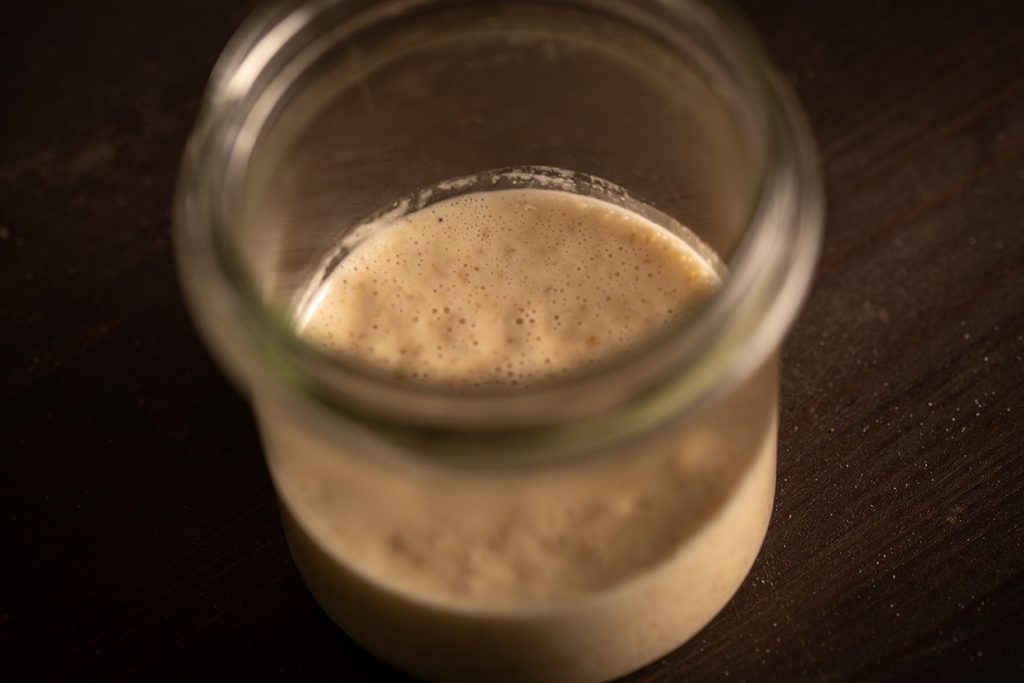How do you know when your starter is ripe and ready to be used for breadmaking? More importantly, how do you know if your starter is able to render a good loaf? The following discussion is regarding stable sourdough starters, if you just began building your starter, you need to take some time to feed it regularly until it stabilizes. Trust the process.
So, once you have a viable sourdough culture, when you see that your starter has fermented (at least doubled its volume ideally even more), proceed as follows:
- Float test – Pour water into a bowl. Add a teaspoon of your starter and see what happens – if it floats, it means that the wild yeasts in your starter are active enough to release carbon dioxide, which in turn makes the starter float. That means your starter is ready.
- Smell your starter – that’s right, smell it. It should smell slightly sour & milky-sweet (think yogurt). The starter should not have a foul smell, should not be extremely acidic or smell/ taste funky. The float test will tell you if your starter is active enough, but it tells you nothing when it comes to the taste profile of your bread, you could end up with a beautiful loaf that is inedible due to sourness or bitterness or simply too funky. Always smell your starter, your nose will give you lots of guidance regarding this.
What your starter should act like
Keep in mind that each starter is different and its behavior depends on many factors – temperature, flours used for feeding, feeding schedule, hydration etc. A rye sourdough starter will smell considerably more sour than a bread flour, but it still shouldn’t smell bad. A good rye starter will have a pleasant smell, in addition to its sourness you should smell flowers, ripe fruit and other pleasant notes.
If your breads always come up very sour, that’s a sign that your starter is producing too much acetic acid. Sourdough, despite its name, should not be overly sour (unless you like it that way), there are sourdough breads out there that are not supposed to taste sour at all. So if your bread is very sour, try troubleshooting your starter as follows:
- If you are using wholemeal or rye flour (even partially), try to gradually phase that out and feed it with bread flour only.
- If you are already feeding it with bread flour, try and increase the feeding ratios. E.g. if you’re feeding it in 1:3:3 ratios, try and increase that to 1:4:4. You may be tempted to feed it 1:1:1 to reduce discard and waste. As difficult as it may be to accept, good breads require a bit of sacrifice and holding on to your flour and skimp on flour for feeding will only make you waste more flour (and time) on bad breads. Trust the process, discard and feed your starter properly.
The best piece of advice anyone can give you is be patient. It takes time for your starter to become stable and it takes time for you to fully understand the complex processes inside that jar. Using discard for breadmaking is not a great idea, it may come out ok-ish, but it may also come out flat or super sour and that is how people end up believing that sourdough tastes sour and nasty. And only because a loaf looks good, doesn’t mean it is good.
So what happens after each starter feeding?
Briefly put, these are the three stages your sourdough starter goes through after you’ve fed it:
- Unripe starter – it smells milky, sweet and like raw flour. A few bubbles start to show up, but only slightly. The starter sinks when put to the float test. That means the starter is not yet ready to be used for breadmaking.

- Ripe starter – it smells sweet&sour and you can notice many large bubbles throughout the starter. The starter floats when placed in a bowl of water. Now is the best time to use it for breadmaking.

- Overproofed starter – the starter has began to collapse after its initial rise and it starts smelling more sour. If you place it in a bowl of water, it sinks. You should first feed your starter and wait until it is ripe to use it for breadmaking.

